Featured
Why the Trade Is Still Worried About Cotton Demand Moving Forward
Cotton was lower last week in sideways trading after another week of very disappointing export sales. Demand has not improved with the reduction in prices to date. China is making some initial moves to open its economy and country again. China is making moves to shore up the housing sector in the country. There are hopes that China is about to open again despite its zero-tolerance Covid policies.

Wheat: Wheat markets were a little lower on follow-through selling tied to news that a new Russia-Ukraine export agreement was reached and exports from both countries will be likely and will likely increase in volume. The weekly charts for all three markets show sideways trends but demand fundamentals remain bearish. A cut in demand and an increase in ending stocks were seen in the reports last week but the increase in ending stocks was only 10 million bushels and smaller than expected. The reduced pace of export sales for the US was bearish. The demand for US Wheat still needs to show up and right now there is no demand news to help support futures.
Weekly Chicago Soft Red Winter Wheat Futures
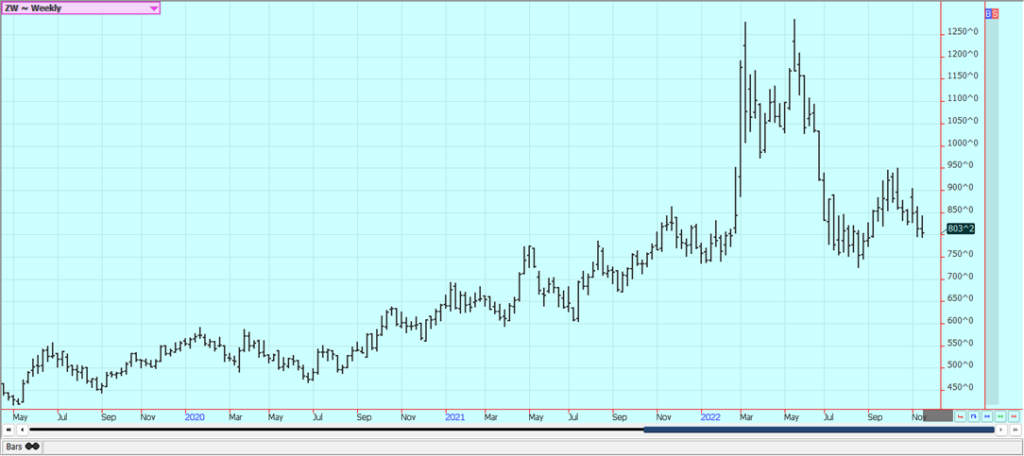
Weekly Chicago Hard Red Winter Wheat Futures
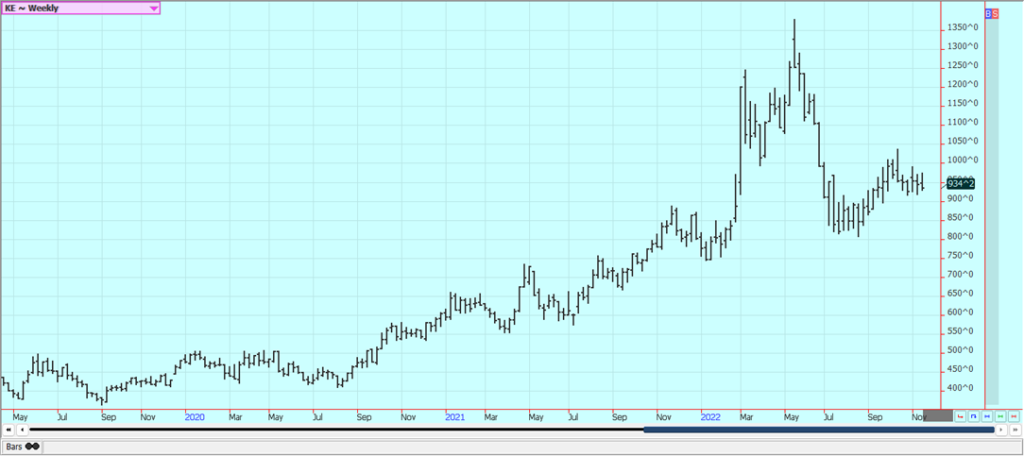
Weekly Minneapolis Hard Red Spring Wheat Futures
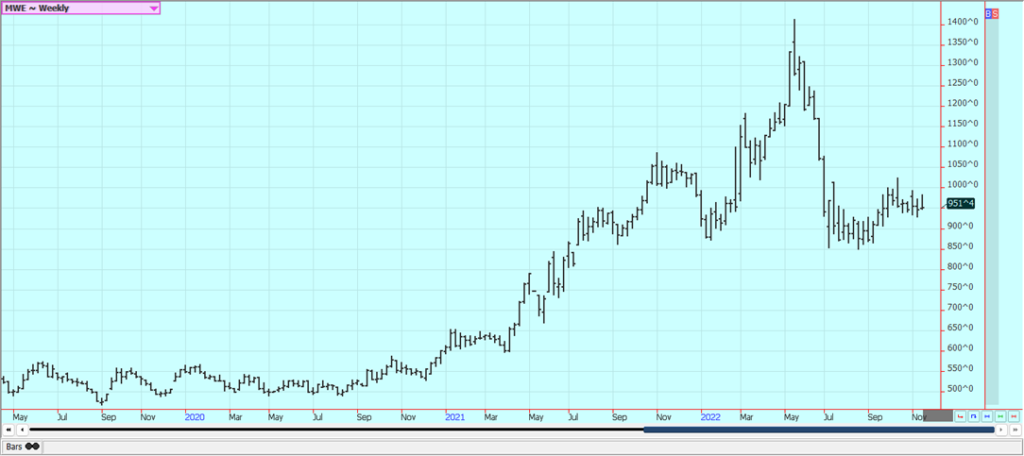
Corn: Corn and Oats closed mixed on Friday on stronger-than-expected weekly export sales for Corn. The weekly charts show that Corn is against resistance areas but Oat appears to be putting together a longer-term bottom. Weak demand overall for US Corn remains a big problem for the market and USDA was expected to cut demand and raise ending stocks in its coming WASDE reports. The Mississippi river remains low due to the dry conditions seen in most of the central parts of the US. Barge traffic has been reduced. Some water has been falling in the basin now in the form of rain and snow so conditions should be improving but the improvement, for now, appears to be short-term. The cash market has been strong in the Gulf but weak in the Midwest river areas due to the low river levels. There are increasing concerns about demand with the Chinese economic problems caused by the lockdowns creating the possibility of less demand as South America has much better crops this year to compete with the US for sales. Export demand in general has been slow so far this year.
Weekly Corn Futures
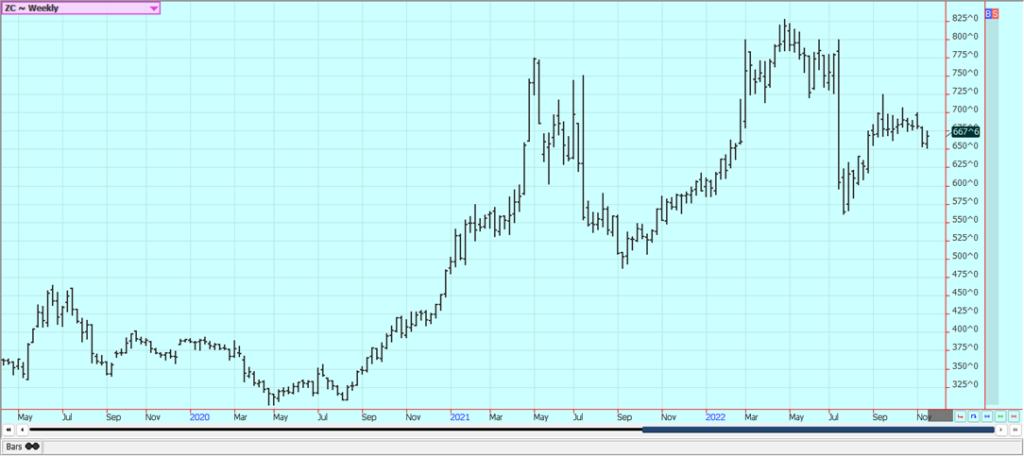
Weekly Oats Futures
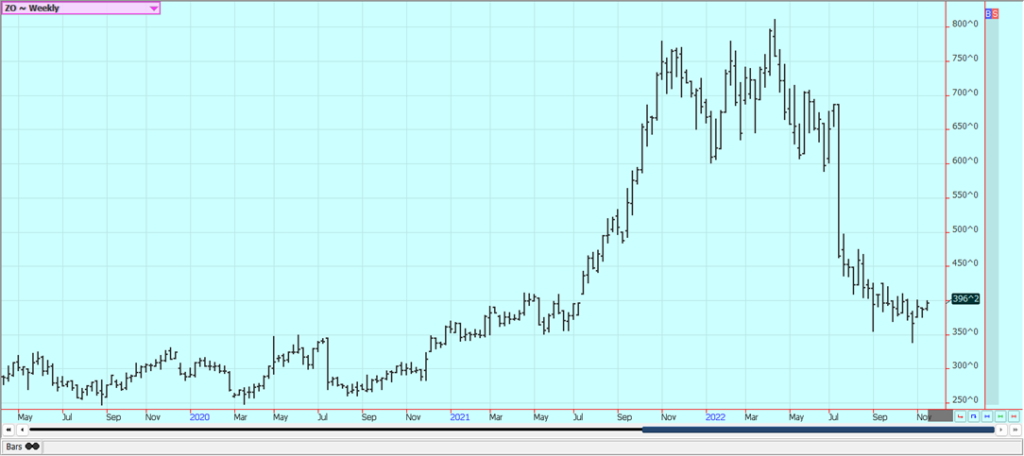
Soybeans and Soybean Meal: Soybeans and the products were higher on Friday but generally lower for the week on ideas that Chinese demand will stay weak overall and that Brazil growing conditions are good and getting better. Only Soybean Meal closed with marginal gains on the weekly charts. The weekly export sales report was stronger than expected on Thursday at well over 3.0 million tons. Export demand for the US is heating up and the new demand could not come at a better time. Domestic demand should be strong for Soybeans as the crush spreads got richer and provided crushers with a big profit margin for their crushing Export demand has suffered due to the lack of good buying by China, but China has been a better buyer in the last couple of weeks. South America as a whole is expected to produce a very big crop later this year for harvest next Spring as the weather outlook is positive for crops. However, a third year of La Nina as predicted by meteorologists could cut the production potential. Production potential is already being hurt in Argentina. Ideas are that Brazil is off to a very good start. The Mississippi river is low due to the dry conditions seen in most of the central parts of the US but some rain fell in the basin last week and river levels should work a little higher. Barge traffic has been reduced but could increase with the improved river flows. US production ideas remain strong after mostly good weather in August. The NOPA crush was 164.464 million bushels this month, in line with trade ideas and the second highest on record.
Weekly Chicago Soybeans Futures:
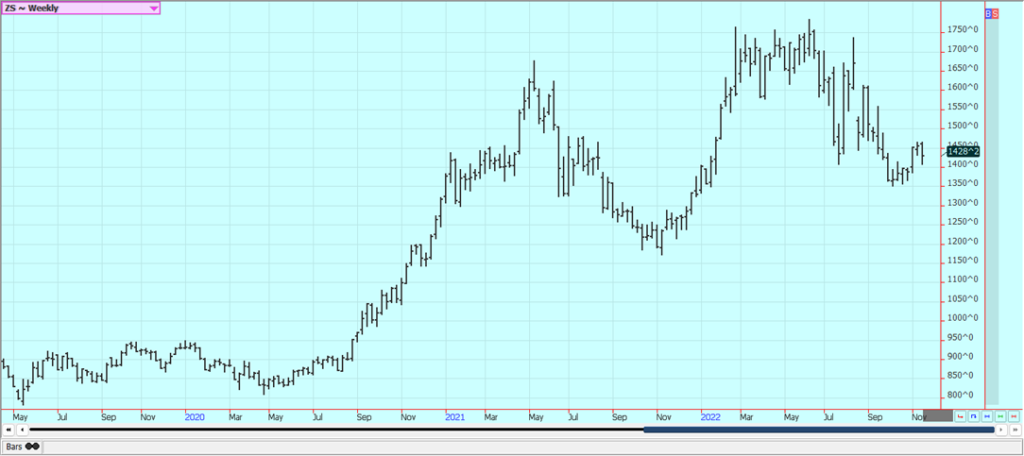
Weekly Chicago Soybean Meal Futures
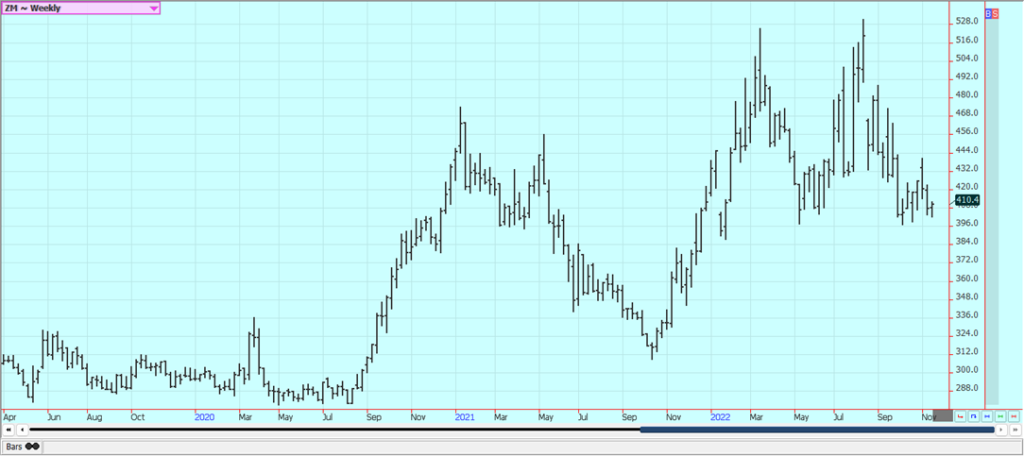
Rice: Rice was higher Friday and trends turned mixed on the daily charts. Futures failed to move above 1800 January again this week but the weekly charts showed a positive close and the potential to finally get above that strong resistance area. It seemed that the market found some Rice this week and now has enough for current needs. Some new Rice producer selling might be found soon as futures and basis are now getting close to being profitable for producers to sell. Most Rice farmers were not paying much attention to the market as they are involved in other pursuits. Demand in general has been slow for Rice for both exports and domestic uses.
Weekly Chicago Rice Futures
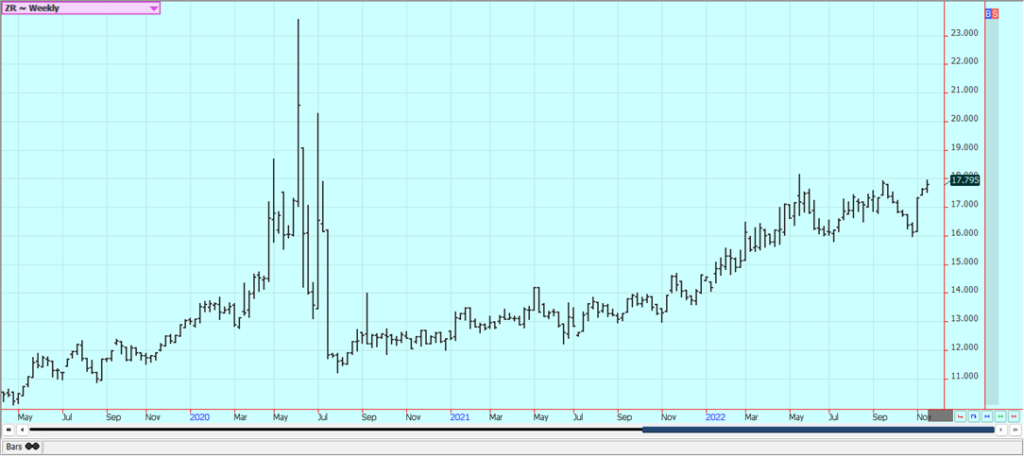
Palm Oil and Vegetable Oils: World vegetable oils prices were lower last week. Palm Oil was closed for a holiday on Friday but closed lower for the week and turned the trends down on the charts. China has tried to relax some Covid restrictions so that quarantines now need to be eight days instead of at least two weeks. However, new outbreaks of the virus are being reported so the cities are still imposing lockdowns. Ideas are that supply and production will be strong, but demand ideas are now weakening and the market will continue to look to the private data for clues on demand and the direction of the futures market. Demand reports for the current month were stronger yesterday. Canola was lower Friday on ideas that Chinese demand can remain weak due to increased outbreaks of Covid there. Reports indicate that domestic demand has been strong due to favorable crush margins.
Weekly Malaysian Palm Oil Futures
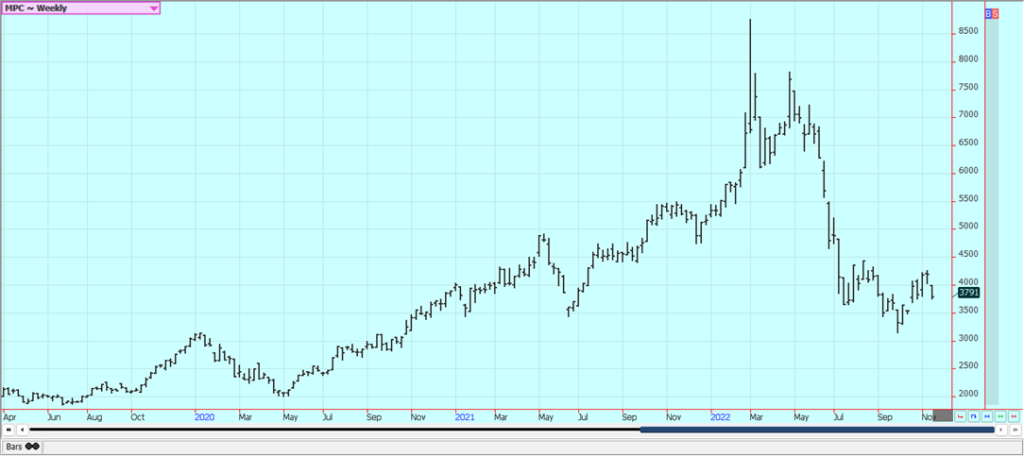
Weekly Chicago Soybean Oil Futures
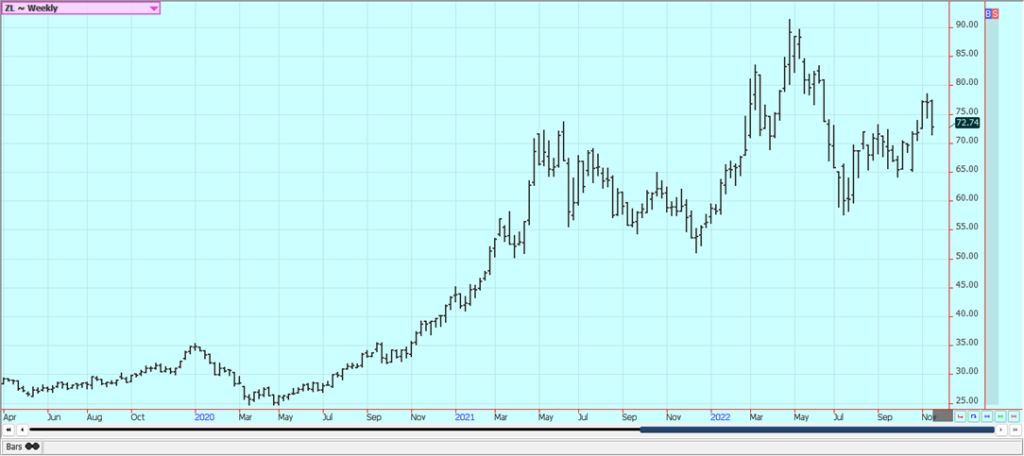
Weekly Canola Futures:
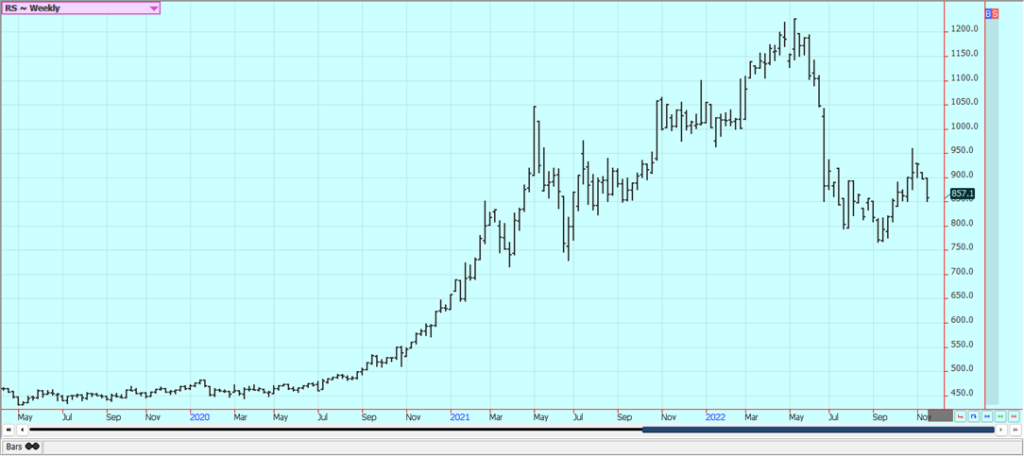
Cotton: Cotton was lower last week in sideways trading after another week of very disappointing export sales. Demand has not improved with the reduction in prices to date. China is making some initial moves to open its economy and country again. China is making moves to shore up the housing sector in the country. There are hopes that China is about to open again despite its zero-tolerance Covid policies. Trends are still mixed on the charts. Production in the US is very short. The trade is still worried about demand moving forward due to recession fears and Chinese lockdowns but is also worried about total US production potential. It is possible that the continued Chinese lockdowns will continue to hurt demand for imported Cotton for that country and that a weaker economy will hurt demand from the rest of the world.
Weekly US Cotton Futures
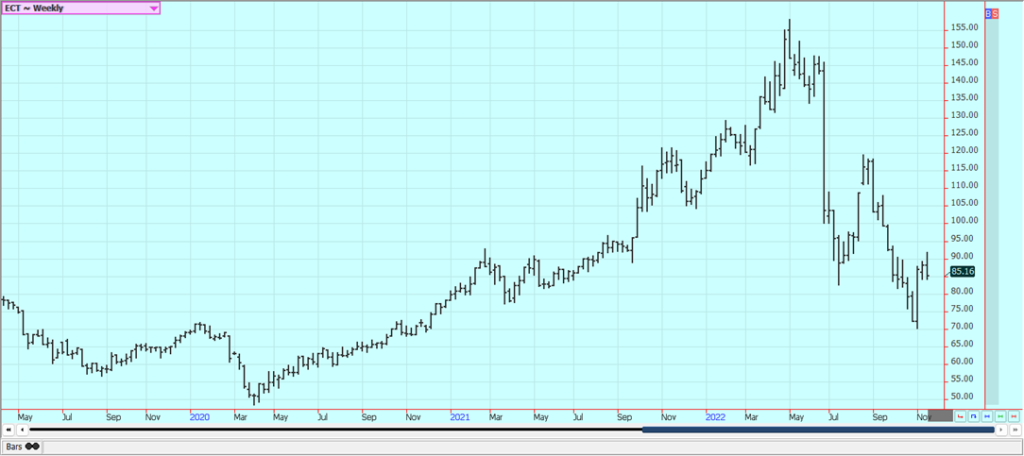
Frozen Concentrated Orange Juice and Citrus: FCOJ was a little lower last week in range trading. It looks like the market is developing a trading range and might have completed a short-term low. Historically low estimates of production due in part to the hurricane and in part to the greening disease have hurt production remain in place. The weather remains generally good for production around the world for the next crop but not for production areas in Florida that have been impacted in a big way by the storm. Brazil has some rain and the conditions are rated good. Mostly dry conditions are in the forecast for the coming days. Florida Dept of Citrus said that retail sales of Orange Juice fell to a three-year low at 28.61 million gallons for October. Prices reached a new high of &8.37 per gallon.
Weekly FCOJ Futures
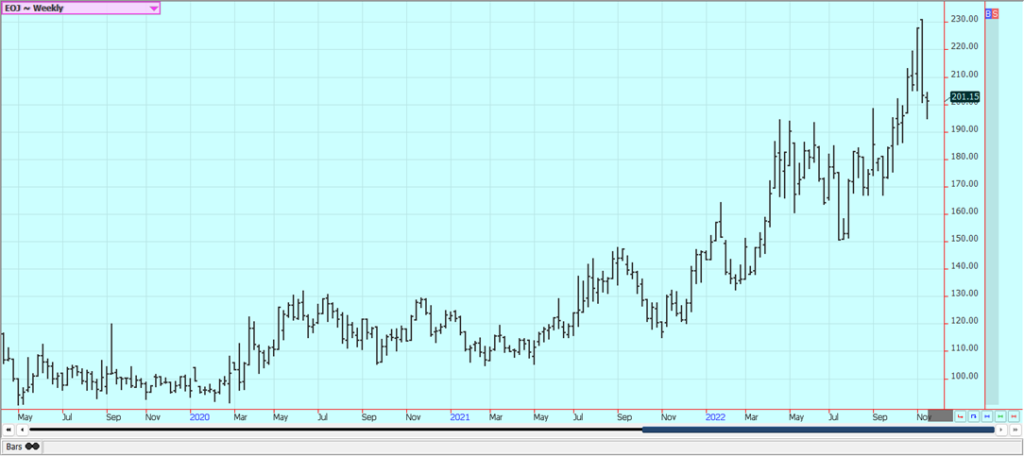
Coffee: New York closed lower and London closed higher Friday. New York and London were both lower for the week with New York taking the biggest hit. The selling came in response to much-improved growing conditions for Coffee this year in Brazil. Weather conditions are good in Brazil and the rest of Latin America and supplies available to the market should keep increasing and the market is looking forward to the increased supplies. Ideas are that the market will have more than enough Coffee when the next harvest comes in a few months. Ideas of a significant recovery in world production next year remains the main cause for any selling. More showers and rains are in the forecast in Brazil Coffee areas for this week. The rest of South America and Central America are reported to be in good condition, although Colombia is recovering from big and excessive rains seen earlier in the development cycle. Vietnam has scattered showers in Coffee areas.
Weekly New York Arabica Coffee Futures
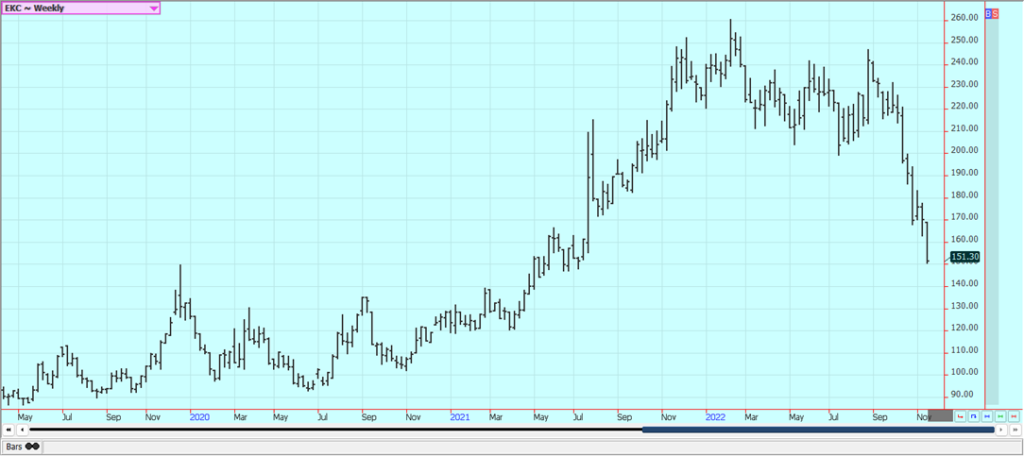
Weekly London Robusta Coffee Futures
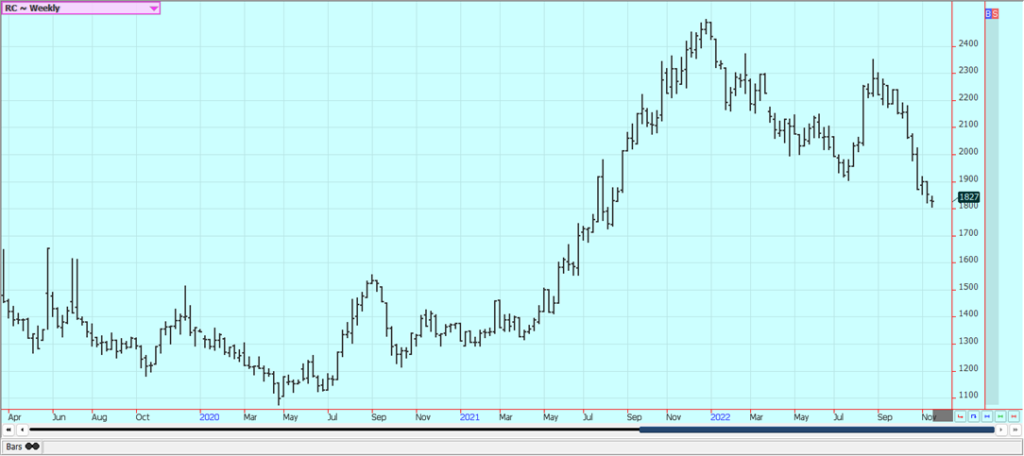
Sugar: New York and London closed higher on Friday, and trends are now mixed in both markets. New York was higher for the week, but London was lower. The weather in Brazil remains good for the next crop. More ideas that supplies of White Sugar would soon be increasing for the market has weighed on prices for the London market. The world Sugar market is expected to be in a big surplus production next year. The supply remains tight for now. Brazil Sugar offers are likely to drop in volume with the return of Lula as president of Brazil. He is much more environmentally focused than the previous president was and is likely to return the ethanol and biofuels mandates to previously higher levels. Indian exporters are now selling into the world market and have been aggressively looking to sign sales contracts. The ISO said this week that world production should increase to 182.14 million tons, a new record and 3.5% above this year. Consumption is expected to be 174.3 million tons, from 175.9 million tons this year. That should be enough Sugar to produce a surplus of 6.18 million tons, from a deficit of 1.66 million tons this year.
Weekly New York World Raw Sugar Futures
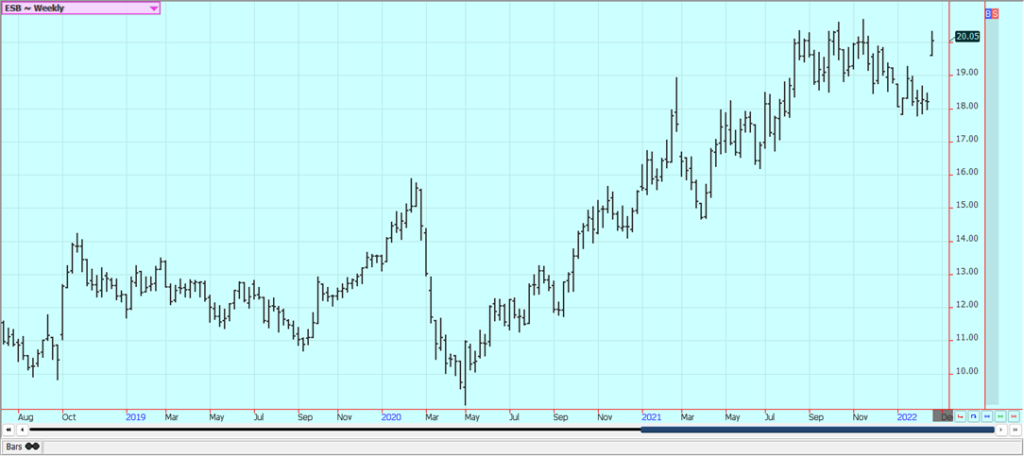
Weekly London White Sugar Futures
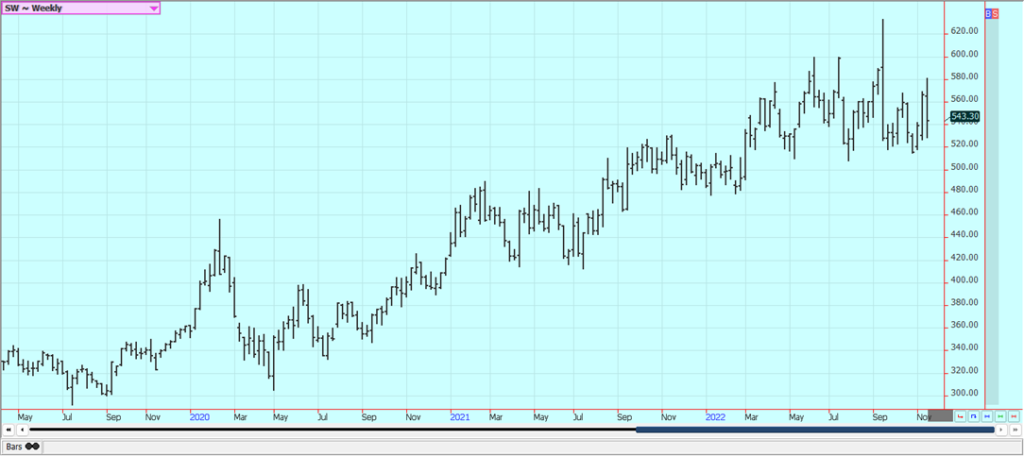
Cocoa: New York and London closed mostly higher on Friday. New York closed sharply lower last week while London closed slightly higher. Trends are down in New York but mixed in London. Ivory Coast arrivals appear to have improved lately with the recent rally in futures prices. Good production is reported and traders are worried about the world economy moving forward and how that could affect demand. Supplies of Cocoa are as large as they will be now for the rest of the marketing year. Reports of scattered showers along with very good soil moisture from showers keep big production ideas alive in Ivory Coast. The weather is good in Southeast Asia.
Weekly New York Cocoa Futures
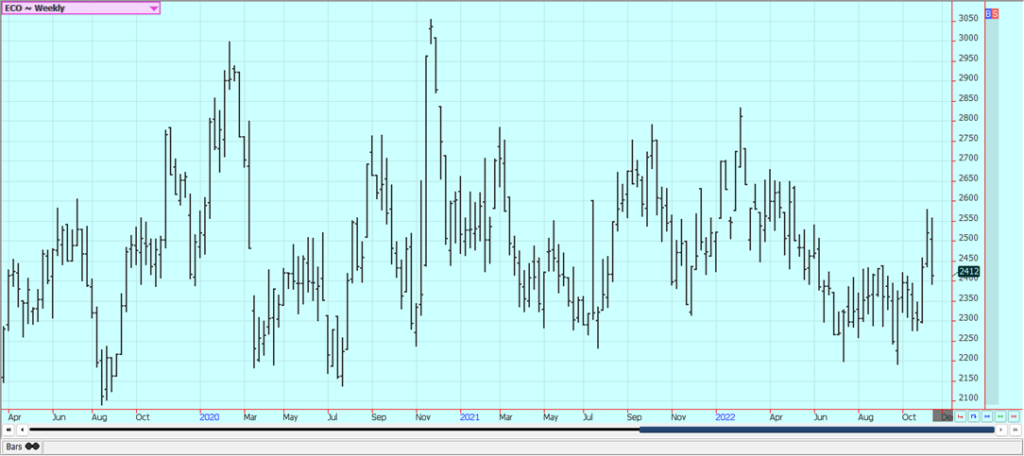
Weekly London Cocoa Futures
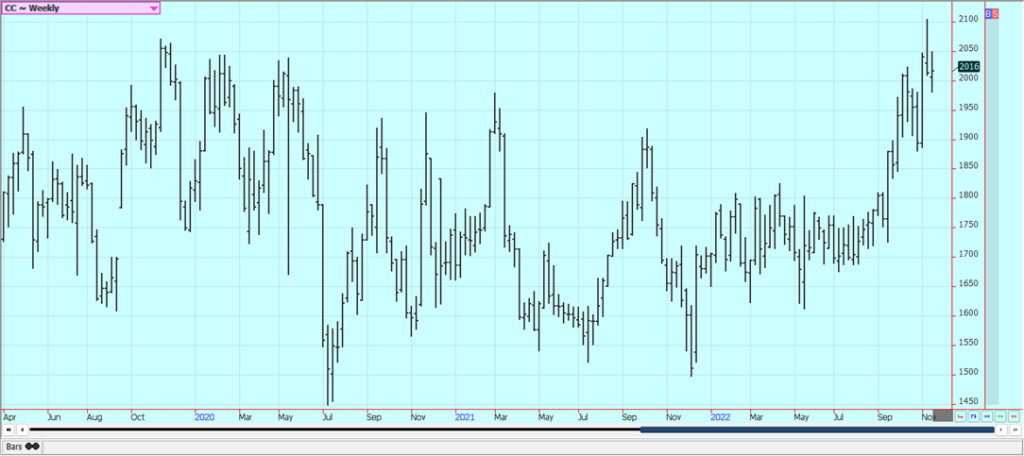
__
(Featured image by pianweizhuannong via Pixabay)
This article may include forward-looking statements. These forward-looking statements generally are identified by the words “believe,” “project,” “estimate,” “become,” “plan,” “will,” and similar expressions. These forward-looking statements involve known and unknown risks as well as uncertainties, including those discussed in the following cautionary statements and elsewhere in this article and on this site. Although the Company may believe that its expectations are based on reasonable assumptions, the actual results that the Company may achieve may differ materially from any forward-looking statements, which reflect the opinions of the management of the Company only as of the date hereof. Additionally, please make sure to read these important disclosures.
Futures and options trading involves substantial risk of loss and may not be suitable for everyone. The valuation of futures and options may fluctuate and as a result, clients may lose more than their original investment. In no event should the content of this website be construed as an express or implied promise, guarantee, or implication by or from The PRICE Futures Group, Inc. that you will profit or that losses can or will be limited whatsoever. Past performance is not indicative of future results. Information provided on this report is intended solely for informative purpose and is obtained from sources believed to be reliable. No guarantee of any kind is implied or possible where projections of future conditions are attempted. The leverage created by trading on margin can work against you as well as for you, and losses can exceed your entire investment. Before opening an account and trading, you should seek advice from your advisors as appropriate to ensure that you understand the risks and can withstand the losses.

-

 Biotech1 day ago
Biotech1 day agoSalmoss Biotech: Turning Salmon Waste Into Breakthroughs in Regenerative Medicine
-

 Markets2 weeks ago
Markets2 weeks agoRice Market Rebounds from Oversold Lows Amid Weak Demand
-

 Crypto1 week ago
Crypto1 week agoEthereum in 2025: Volatility, Maturity, and Strategic Renewal
-

 Crowdfunding1 day ago
Crowdfunding1 day agoSumar Inversión Closes 2025 With Solid Returns and Growing Trust























